
"His intention, he stated, was never to reveal the intergluteal cleft - or crack, as we more colloquially put it - but to experiment with attenuated tailoring. "They were never really about the bum," he said in 1996. "They were a technical experiment in how to elongate the torso." Nevertheless, he did christen them bumsters - he also mooned the press a few times in place of the usual polite designer bow, as if to underline the reference."
"Lee Alexander McQueen introduced his radical bumsters in his very first collection, Taxi Driver, named after the 1976 Martin Scorsese movie and presented on a rail at the Ritz hotel in London for Autumn/Winter 1993. The bumsters originated in McQueen's teenage training at Anderson & Sheppard Savile Row - as a result, he knew how to precisely calculate the cut to ensure the trousers stayed up, despite their minute 'rise' (the distance from the top of waistband to middle of the crotch seam, between the legs)."
The buttock carries pronounced symbolic and formal weight within Alexander McQueen's aesthetic, frequently used to probe sexuality and erogenous-zone perceptions. Seán McGirr's Spring/Summer 2026 collection revived McQueen's low-slung bumster references and employed artful cut-outs to highlight the posterior. McQueen first presented bumsters in Taxi Driver (Autumn/Winter 1993), informed by Savile Row training that enabled precise calculation of an ultra-low rise that nevertheless kept trousers secure. The bumster aimed to experiment with attenuated tailoring and elongate the torso rather than simply expose the intergluteal cleft. Several shows paradoxically kept buttocks covered while emphasizing perilously low waistlines.
Read at AnOther
Unable to calculate read time
Collection
[
|
...
]